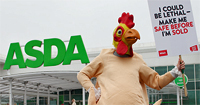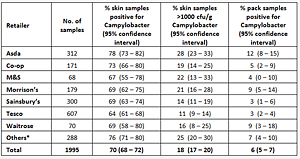The Food Standards Agency (FSA) has published the results from the first two quarters of its year-long survey of Campylobacter on fresh chickens.
With around 100 deaths a year linked to Campylobacter, we are not talking about a minor stomach bug!
The FSA's survey found 70% of chickens tested positive for the presence of Campylobacter with 18% above the highest level of contamination. The findings also showed 6% of packaging tested positive for the presence of Campylobacter too.
Asda’s samples tested highest for levels of Campylobacter at 78%. This was followed by the Co-operative Food (73%), Morrisons (69%), Waitrose (69%), Sainsbury’s (69%), Marks and Spencer (67%) and Tesco (64%).
The FSA's policy director, Steve Wearne, said:
"These results show that the food industry, especially retailers, need to do more to reduce the amount of Campylobacter on fresh chickens… There is a long way to go before consumers are protected from this bug."
 Now the consumer campaigning organisation, Which? has drawn up a campaign and associated petition against the appalling risk to human health as a result of the supermarkets indifference to their responsibility of protecting their customers from ill-health due to consuming contaminated foods.
Now the consumer campaigning organisation, Which? has drawn up a campaign and associated petition against the appalling risk to human health as a result of the supermarkets indifference to their responsibility of protecting their customers from ill-health due to consuming contaminated foods.
Click the pic on the left to sign the petition.
In its latest press release, the organisation warns:
New Which? research shows that 6 in 10 people are concerned about Campylobacter in chicken. Campylobacter is the most common cause of food poisoning in the UK.
Here’s what Which supporter Helene told us –
"I contracted Campylobacter from a free range chicken purchased at a reputable supermarket chain. I took all necessary precautions with handling and cooking. I became very ill very rapidly, and tests confirmed I had contracted Campylobacter. I was ill for weeks, and it took my system months to get back to normal. I would not wish this on my worst enemy."
We’re calling on the whole industry to clean up their act. Supermarkets, the Food Standards Agency and the chicken processing industry must immediately set out the action they will take to bring Campylobacter under control.
Which? executive director, Richard Lloyd, said:
"These results are a damning indictment of supermarkets and consumers will be rightly shocked at the failure of trusted household brands to stem the tide of increasingly high levels of Campylobacter. Supermarket bosses should hang their heads in shame."
 He added:
He added:
"
It's now vital that the industry cleans up its act and works hard to restore consumer confidence. We want to see supermarkets not only publishing effective plans that tackle these scandalously high levels but also demonstrate they're taking real action to make chicken safe."
But it is not only supermarkets that pose a risk to our health. Fast food chains, restaurants and mobile food providers also present a risk. Food poisoning is a major concern and is a notifiable illness which should be reported to local authorities, but how many
actually do when they have contracted food poisoning on a night out?
In the UK, campylobacter is the most common bacterial cause of food poisoning. Campylobacter bacteria are usually found on raw or undercooked meat (particularly poultry), unpasteurised milk and untreated water. Undercooked chicken liver and liver pâté are also common sources. The incubation period (the time between eating contaminated food and the onset of symptoms) for food poisoning caused by campylobacter is 2-5 days.
The fact of the matter is that food poisoning can, and does KILL!
Source: NHS / Which? / FSA